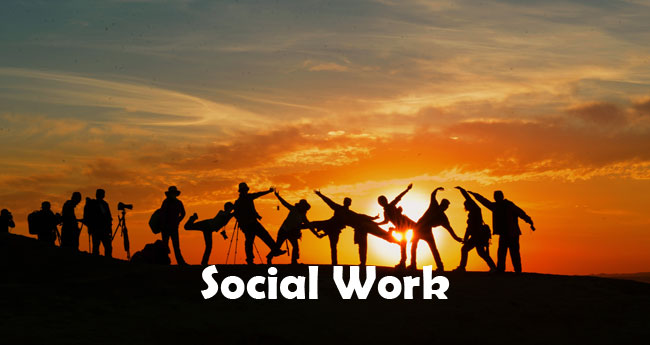UPSC Social Work Questions and Answers
UPSC Social Work Questions and Answers is available here for the reference of Union Public Service Commission Exam applicants. The UPSC Social Work Syllabus and Exam Pattern will help the aspirants to identify the Subjects, type of questions, Marks allotted for each section, and Cut Off Marks.

The table describes the UPSC Social Work Exam Paper Pattern and tap on the direct link for the detailed Union Public Service Commission Exam Pattern. The UPSC Social Work Exam applicants can visit this page for the precious material.
The applied candidates can also allow downloading the Union Public Service Commission Social Work Exam Model Question Papers from our website. The Union Public Service Commission Previous Papers will be helpful for the candidates to know the pattern of the UPSC Social Work Written Examination.
Questions and Answers for UPSC Social Work
1. Review of literature is …………… .
(A) Reviewing Newspaper
(B) Assessing Research
(C) Examining Books, Articles, Research
(D) Review of Audited Reports
2. Article 22 of the Universal Declaration of Human Rights, declares that :
(A) everyone, as a member of society, has the right to social security
(B) everyone, as a member of society, has the right to social welfare
(C) everyone, as a member of society, has the right to social policy
(D) everyone, as a member of society, has the right to social service
3. The National Commission for Women Bill was passed by the Lok Sabha on :
(A) 9th August 1970
(B) 9th August 1980
(C) 9th August 1990
(D) 9th August 2000
4. ……………….. from different states of Indian Union for national level organizations, can come together to establish a voluntary organization and start running it.
(A) Eight persons
(B) Nine persons
(C) Ten persons
(D) Eleven persons
5. Social welfare administration is a :
(A) Primary method of social work
(B) Secondary method of social work
(C) Tertiary method of social work
(D) Mixed method of social work
6. The acronym ‘CBO’ stands for :
(A) Central Bank of Odisha
(B) Community Based Organisation
(C) Centre of Business
(D) Community Based Ordinance
7. Which one of the following theories assumes welfare is a legal or statutory responsibility of the employer ?
(A) Paternalistic theory
(B) Policing theory
(C) Philanthropic theory
(D) Placating theory
8. Help Age International Network was established in the year :
(A) 1953
(B) 1963
(C) 1973
(D) 1983
9. …………….. refers to benefits or services, which people receive in lieu of contributions to an insurance programme.
(A) Social welfare
(B) Social assistance
(C) Social service
(D) Social insurance
10. Which one of the following principles is not the principle of social welfare administration ?
(A) The Principle of Individulisation
(B) The Principle of Professional Responsibility
(C) The Principle of Agency Purpose
(D) The Principle of Cultural Setting
11. The Indian Societies Registrations Act, was enacted in the year ………. .
(A) 1860
(B) 1947
(C) 1956
(D) 1960
12. ‘To actualise the goal of cooperative federalism, competitive federalism and enable good governance in India’ is one of the key objectives of which agency ?
(A) UGC
(B) Niti Ayog
(C) PMO
(D) Start Up India
13. The welfare, social justice and empowerment of disadvantaged and marginalised sections of the society is entrusted with …………….. .
(A) Ministry of Welfare
(B) Ministry of Social Defence
(C) Ministry of Social Justice and Empowerment
(D) Ministry of Labour Welfare
14. National Policy on Education was approved in the year :
(A) 1986
(B) 1985
(C) 1990
(D) 1984
15. Which one of the following Five Year Plans is called as “Gadgil Yojana” ?
(A) First Five Year Plan
(B) Second Five Year Plan
(C) Third Five Year Plan
(D) Fourth Five Year Plan
16. Which one of the following models is not suggested by Richard Titmus ?
(A) Industrial Achievement-Performance Model
(B) Residual Welfare Model
(C) Economic Redistributive Model
(D) Institutional Redistributive Model
17. Is ……………… incorporated in Sustainable Development Goals ?
(A) Gender inequality
(B) Infant mortality
(C) Gender discrimination
(D) Good health and well being
18. Every child with disability shall have the rights to free education till the age of ……………… years.
(A) 12
(B) 15
(C) 16
(D) 18
19. Human Rights could be generally defined as ……………. .
(A) Rights that are inherent in our nature
(B) Fundamental rights
(C) Rights without which human being cannot live
(D) All the above
20. Which is the first UN instrument that recognizes the importance and legitimacy of the work of human rights defenders ?
(A) UN Declaration on Protection of Human Rights Activists, 1993
(B) UN Declaration on Human Rights Defenders, 1998
(C) UN Declaration on Security and Protection to Human Rights Activists, 1993
(D) UN Declaration on Security of Activists, 1993
| Interview | Objective |
| UPSC | Quiz |
| UGC NET | GK |
| LMSW | MCQ |
| MSW |
21. Section 2 of the PHRA defines Human Rights as :
(A) Rights relating to life, liberty and religious freedom of the individual
(B) Rights relating to life, liberty and electoral freedom of the individual
(C) Rights relating to life, liberty, constitutional freedom of the individual
(D) Rights relating to life, liberty, equality and dignity of the individual
22. The ……………… is a non-binding declaration adopted by the United Nations General Assembly in 1948.
(A) Treaty of Versailles
(B) Universal Declaration of Human Rights (UDHR)
(C) International Humanitarian Law (IHL)
(D) International Human Rights Law
23. Where is the Headquarters of UNHCR ?
(A) Geneva
(B) Hague
(C) Amsterdam
(D) Denmark
24. The concept of social justice in the Indian Constitution denotes the :
(A) Equal treatment of all citizens based on economic criteria
(B) Equal treatment of all citizens without any social distinction
(C) Equal treatment of all citizens on the basis of reservation based on caste
(D) Equal treatment of all citizens on the basis of regional imbalances
25. The Directive Principles of State Policy are :
(A) Guidelines on the fundamental obligations of the states to its citizens
(B) Declaration of the intent of the government to form the election commission
(C) Declaration for the formation of a democratically elected government
(D) Guidelines on the framing of tax laws in the country
26. The Constitution of India assures its citizens :
(A) Justice, equality, liberty and socialism
(B) Justice, equality, liberty and secularism
(C) Justice, equality, liberty and federalism
(D) Justice, equality, liberty and fraternity
27. Who was the Chairman of the Drafting Committee of the Indian Constitution ?
(A) Dr. Rajendra Prasad
(B) Dr. B. R. Ambedkar
(C) Mr. Vallabhbhai Patel
(D) Mr. Abdul Kalam Azad
28. In which year was The National Food Security Act implemented ?
(A) 2000
(B) 2010
(C) 2013
(D) 2015
29. The issues related with older people are addressed by the Central Government under the division of :
(A) Social Defence
(B) Social Aging
(C) Geriatrics
(D) Gerontology
30. A small percentage of individuals with mental health issues, involved in violent crimes are called :
(A) Sociopaths
(B) Schizophrenics
(C) Psychopaths
(D) Violent criminals
31. Culturally determined characteristics associated with maleness or femaleness can be referred to as :
(A) Racial Discrimination
(B) Equality
(C) Women’s Liberation
(D) Gender
32. The addition of ……………… as a new disability under the Rights of Persons with Disabilities Act allowed a girl with this disorder to get admission to medical course.
(A) Mental Illness
(B) Depression
(C) Thalassemia
(D) Speech Disorder
33. Access audit with reference to disability refers to :
(A) Auditing access of persons with disabilities to social service and health facilities
(B) Making buildings, campus and other public facilities accessible to persons with disability
(C) Undertaking financial audit to assess the expenditure on disability related benefits
(D) Limiting access of persons with disability to high risk areas
34. Which of the following are not the functions of medical social worker ?
(A) Improving quality of life of patients and rehabilitation
(B) Social diagnosis and case work
(C) Counselling and advocating rights of patients
(D) Palliative care and prognosis
35. Mental hygiene movement was an outcome of …………. .
(A) Psychoanalytic approach
(B) Positive psychology
(C) The mind that found itself
(D) Dream analysis
36. Which one of the following Sections of the Factories Act provides for extra wages for overtime ?
(A) 29
(B) 39
(C) 49
(D) 59
37. Name the agency which was set up under one of the provisions of the NDPS Act to oversee the drug situation in India :
(A) Dangerous Drugs Control Agency
(B) Controller of Intoxicating Substances
(C) Narcotics Control Bureau
(D) Indian Bureau of Narcotic Drugs
38. Who are the beneficiaries of the ICDS in India ?
(A) Children under 5 years of age and their mothers
(B) Children under 5 years of age and their siblings
(C) Children under 6 years of age and their siblings
(D) Children under 6 years of age and their mothers
39. Social skills that enrich human development do not include :
(A) Building self-confidence and self-esteem
(B) Acquiring livelihood skills
(C) Developing problem solving skills
(D) Improving communication skills
40. Family Life Education does not include understanding of :
(A) Self and others
(B) Sexuality
(C) Political rights of citizens
(D) Marriage and parenthood
41. Childline services aim at helping children during times of :
(A) Normal situations
(B) Emergency
(C) Festivals
(D) Natural calamities
42. Which is not a division of the National Disaster Management Authority ?
(A) Policy and Planning
(B) Mitigation
(C) Operations and Communications
(D) Finance
43. Emergency response refers to :
(A) Actions undertaken as soon as a disaster strikes
(B) Actions taken after an emergency to help minimize the negative effects
(C) Actions coordinating first responders and volunteers after a disaster
(D) Actions taken by the State Administration
44. The acronym CARA stands for :
(A) Council for Adoption and Research Agencies
(B) Centre for Action and Research Activities
(C) Central Adoption Resource Agency
(D) Central Action and Research Agency
45. Name of the Act that prohibits a person to produce/manufacture/ cultivate drugs in India :
(A) Narcotic Drugs and Psychoactive Compounds Act
(B) Narcotic Drugs and Psychotropic Substances Act
(C) Narcotic Drugs and Psychiatric Substances Act
(D) Narcotic Drugs and Psychoanalytic Substances Act

